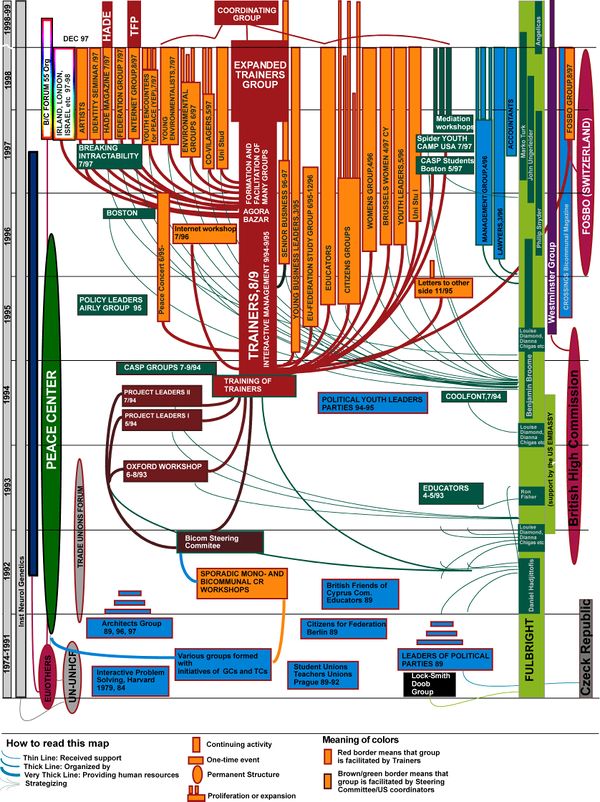Historical overview of all bi-communal groups created and facilitated by the CRTG
This illustration was created by Yiannis Laouris in 1997 to summarize in a graphical format all bicommunal initiatives between 1974 and 1997, with a special focus in the work conducted by the Conflict Resolution Trainers Group (CRTG). It has later been amended and published in Laouris & Laouri (2004)[1] and Laouris et al (2009)[2]
The CRTG is shown as a vertical brown box in the middle (labelled ‘‘Trainers’’) (Fig. 5). New groups created by members of the CRTG following their ‘‘Agora/Bazar’’ pubic invitation are shown as vertical orange rectangles. Each group, totalling approximately 40, was composed of an equal number of TCs and GCs. Twenty-four groups were formed, some of which later produced multiple spin-offs (shown as thin vertical rectangles). A total of over 2,000 were introduced to the concepts of conflict resolution and structured dialogue. Primarily the members of these groups subsidized their training and related activities. Fulbright and its Executive Director Mr. Daniel Hadjittofis provided space, logistical support and inspiration. Although the UN and many foreign diplomatic missions morally supported these efforts, they were not able to make funds available when needed. A UNDP fund provided through their project UNOPS was first made available in year 2000 when this whole movement was practically worn out. All meetings and activities were banned in December 1997. Only the bi-communal forum, the peace magazine ‘‘Hade,’’ the technology-assisted communication project ‘‘tech4peace’’ Technology for Peace, a coordinating group and some citizen groups remained active. The 1,000 TCs who had the opportunity to participate managed to create momentum within the 5-times smaller TC community. Those who did not have the opportunity to participate (the great majority of the south) became suspicious and eventually hostile to the initiative.
- ↑ Laouris, Y., & Laouri, R. (2008). Can information and mobile technologies serve to close the economic, educational, digital, and social gaps and accelerate development?. World Futures, 64(4), 254-275.
- ↑ Laouris, Y., Michaelides, M., Damdelen, M., Laouri, R., Beyatli, D., & Christakis, A. (2009). A systemic evaluation of the state of affairs following the negative outcome of the referendum in Cyprus using the structured dialogic design process. Systemic Practice and Action Research, 22(1), 45-75.
